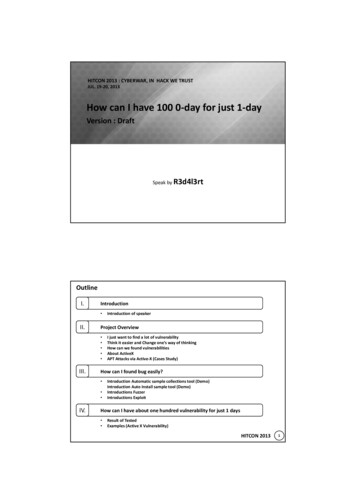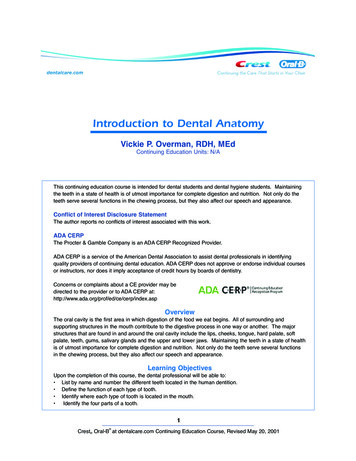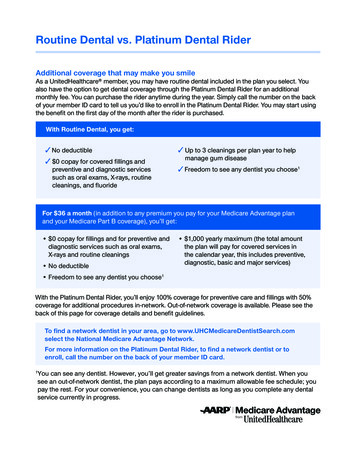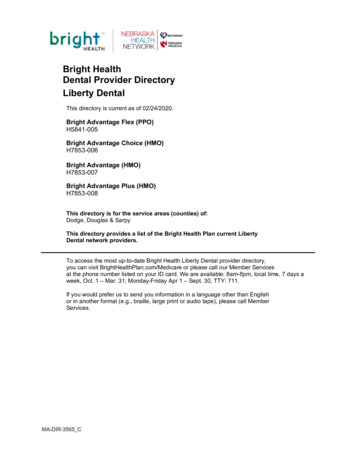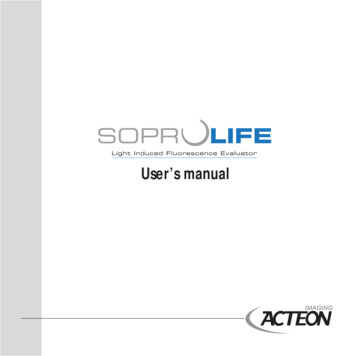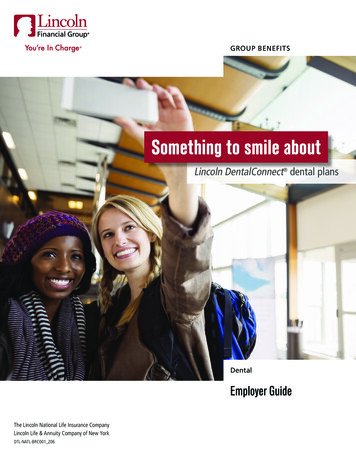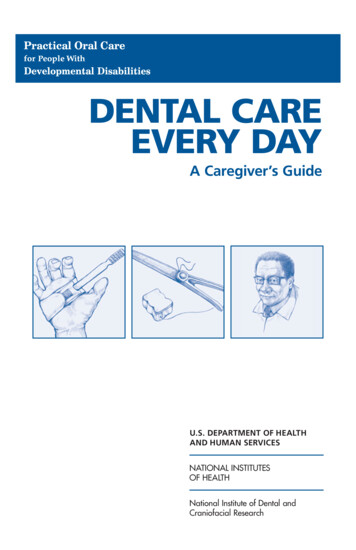
Transcription
DENTAL CAREEVERY DAYA Caregiver’s GuideU.S. DEPARTMENT OF HEALTHAND HUMAN SERVICESNATIONAL INSTITUTESOF HEALTHNational Institute of Dental andCraniofacial Research
ContentsGetting Started . 2Three Steps to a Healthy Mouth . 3Step 1. Brush Every Day . 4Step 2. Floss Every Day . 6Positioning Your Body: Where To Sit or Stand . 8Step 3. Visit a Dentist Regularly . 9Prepare for Every Dental Visit: Your Role . 9ACKNOWLEDGMENTSThe National Institute of Dental and Craniofacial Research thanksthe oral health professionals and caregivers who contributedtheir time and expertise to reviewing and pretesting thePractical Oral Care series.Expert Review Panel Mae Chin, RDH, MEd, University of Washington, Seattle, WA Sanford J. Fenton, DDS, University of Texas, Houston, TX Ray Lyons, DDS, FADPD, DABSCD, New Mexico Department ofHealth, Los Lunas, NM Christine Miller, RDH, MHS, MA, University of the Pacific,San Francisco, CA Steven P. Perlman, DDS, MScD, Boston University, Boston, MA David Tesini, DMD, MS, Sudbury, MA
DENTAL CARE EVERY DAYA Caregiver’s GuideTaking care of someone with a developmentaldisability requires patience and skill. As acaregiver, you know this as well as anyone does.You also know how challenging it is to help thatperson with dental care. It takes planning, time, and theability to manage physical, mental, and behavioral problems.Dental care isn’t always easy, but you can make it work for youand the person you help. This booklet will show you how tohelp someone brush, floss, and have a healthy mouth.Everyone needs dental care every day. Brushing and flossingare crucial activities that affect our health. In fact, dental careis just as important to your client’s health and daily routine astaking medications and getting physical exercise. A healthymouth helps people eat well, avoid pain and tooth loss, andfeel good about themselves.1
Getting StartedLocation. The bathroom isn’t the only place to brushsomeone’s teeth. For example, the kitchen or dining roommay be more comfortable. Instead of standing next to abathroom sink, allow the person to sit at a table. Place thetoothbrush, toothpaste, floss, and a bowl and glass of wateron the table within easy reach.No matter what location you choose, make sure you havegood light. You can’t help someone brush unless you can seeinside that person’s mouth. Page 8 lists ideas on how to sit orstand when you help someone brush and floss.Behavior. Problem behavior can make dental care difficult.Try these ideas and see what works for you.At first, dental care can be frightening to some people. Trythe “tell-show-do” approach to deal with this natural reaction.Tell your client about each step before you do it. For example,explain how you’ll help him or her brush and what it feels like.Show how you’re going to do each step before you do it.Also, it might help to let your client hold and feel thetoothbrush and floss. Do the steps in the same way thatyou’ve explained them.2
Give your client time to adjust to dental care. Be patientas that person learns to trust you working in and aroundhis or her mouth.Use your voice and body to communicate that you care.Give positive feedback often to reinforce good behavior.Have a routine for dental care. Use the same techniqueat the same time and place every day. Many people withdevelopmental disabilities accept dental care when it’sfamiliar. A routine might soothe fears or help eliminateproblem behavior.Be creative. Some caregivers allow their client to hold afavorite toy or special item for comfort. Others make dentalcare a game or play a person’s favorite music. If none ofthese ideas helps, ask your client’s dentist or dentalhygienist for advice.Three Steps to a Healthy MouthLike everyone else, people with developmental disabilitiescan have a healthy mouth if these three steps are followed:1. Brush every day.2. Floss every day.3. Visit a dentist regularly.3
Step 1. Brush Every DayIf the person you care for is unable to brush, these suggestionsmight be helpful.First, wash your hands and put on disposable gloves. Sit orstand where you can see all of the surfaces of the teeth.Be sure to use a regular or power toothbrush with soft bristles.Use a pea-size amount of toothpaste with fluoride, or noneat all. Toothpaste bothers people who have swallowingproblems. If this is the case for the person you care for,brush with water instead.Brush the front, back, and top ofeach tooth. Gently brush backand forth in short strokes.Gently brush the tongue after youbrush the teeth.Angle the brush at thegumline and brush gently.Help the person rinse with plain water.Give people who can’t rinse a drink of water or considersweeping the mouth with a finger wrapped in gauze.Get a new toothbrush with soft bristles every3 months, after a contagious illness, or when thebristles are worn.If the person you care for can brush but needs some help, theideas listed on the next page might work for you. You maythink of other creative ways to solve brushing problems basedon your client’s special needs.4
Make the toothbrush easier to hold.The same kind of Velcro strap usedto hold food utensils is helpful forsome people.Others attach the brush to the hand witha wide elastic or rubber band. Make surethe band isn’t too tight.Make the toothbrush handle bigger.You can also cut a small slit in the side ofa tennis ball and slide it onto the handle ofthe toothbrush.You can buy a toothbrush with a largehandle, or you can slide a bicycle griponto the handle. Attaching foam tubing,available from home health care catalogs,is also helpful.Try other toothbrush options.Guide the toothbrush.A power toothbrush might make brushingeasier. Take the time to help your clientget used to one.Help brush by placing yourhand very gently over yourclient’s hand and guiding thetoothbrush. If that doesn’twork, you may need to brushthe teeth yourself.5
Step 2. Floss Every DayFlossing cleans between the teeth where a toothbrush can’treach. Many people with disabilities need a caregiver to helpthem floss. Flossing is a tough job that takes a lot of practice.Waxed, unwaxed, flavored, or plain floss all do the same thing.The person you care for might like one more than another, ora certain type might be easier to use.Use a string of floss 18 inches long. Wrap that piecearound the middle finger of each hand.Grip the floss between the thumb and index fingerof each hand.Start with the lower front teeth, then floss the upper frontteeth. Next, work your way around to all the other teeth.6
Work the floss gently between the teeth until it reaches thegumline. Curve the floss around each tooth and slip it underthe gum. Slide the floss up and down. Do this for both sidesof every tooth, one side at a time.Adjust the floss a little as you move from tooth to toothso the floss is clean for each one.Try a floss holder.If you have trouble flossing, try using a floss holderinstead of holding the floss with your fingers.The dentist may prescribe a special rinse for your client.Fluoride rinses can help prevent cavities. Chlorhexidinerinses fight germs that cause gum disease. Follow thedentist’s instructions and tell your client not to swallow anyof the rinse. Ask the dentist for creative ways to use rinsesfor a client with swallowing problems.7
Positioning Your Body:Where To Sit or StandKeeping people safe when you clean their mouth is important.Experts in providing dental care for people with developmentaldisabilities recommend the following positions for caregivers.If you work in a group home or related facility, get permissionfrom your supervisor before trying any of these positions.If the person you’re helping is in awheelchair, sit behind it. Lock thewheels, then tilt the chair into your lap.Stand behind the person or lean against awall for additional support. Use your armto hold the person’s head gently againstyour body.8
Step 3. Visit a Dentist RegularlyYour client should have regular dental appointments.Professional cleanings are just as important as brushingand flossing every day. Regular examinations can identifyproblems before they cause unnecessary pain.As is the case with dental care at home, it may take time forthe person you care for to become comfortable at the dentaloffice. A “get acquainted” visit with no treatment providedmight help: The person can meet the dental team, sit in thedental chair if he or she wishes, and receive instructions onhow to brush and floss. Such a visit can go a long waytoward making dental appointments easier.Prepare for Every Dental Visit: Your RoleBe prepared for every appointment. You’re an importantsource of information for the dentist. If you have questionsabout what the dentist will need to know, call the officebefore the appointment.Know the person’s dental history. Keep a record ofwhat happens at each visit. Talk to the dentist about whatoccurred at the last appointment. Remind the dental teamof what worked and what didn’t.Bring a complete medical history. The dentist needseach patient’s medical history before treatment can begin.Bring a list of all the medications the person you care foris taking and all known allergies.Bring all insurance, billing, and legal information.Know who is responsible for payment. The dentist mayneed permission, or legal consent, before treatment canbegin. Know who can legally give consent.Be on time.9
Remember Brushing and flossing every day and seeing the dentistregularly can make a big difference in the quality of life ofthe person you care for. If you have questions or need moreinformation, talk to a dentist.Other booklets in this series:Continuing Education: Practical Oral Care for PeopleWith Developmental DisabilitiesPractical Oral Care for People With AutismPractical Oral Care for People With Cerebral PalsyPractical Oral Care for People With Down SyndromePractical Oral Care for People With Intellectual DisabilityWheelchair Transfer: A Health Care Provider’s GuideNational Instituteof Dental andCraniofacialResearchCenters forDisease Controland PreventionSAFER HEALTHIER PEOPLETMSpecial CareDentistryAssociationFor additional copies of this booklet, contactNational Institute of Dental and Craniofacial ResearchNational Oral Health Information Clearinghouse1 NOHIC WayBethesda, MD ih.govThis publication is not copyrighted.Make as many photocopies as you need.NIH Publication No. 12–5191February 2012NIH Turning Discovery Into Health
The National Institute of Dental and Craniofacial Research thanks the oral health professionals and caregivers who c ontributed . University of the Pacific, San Francisco, CA Steven P. Perlman, DDS, MScD, Boston University, Boston, MA David Tesini, DMD, MS, Sudbury, MA. 1. DENTAL

